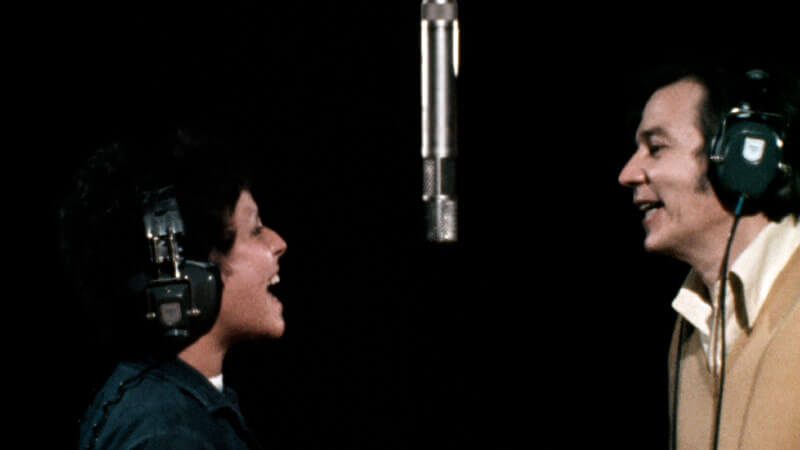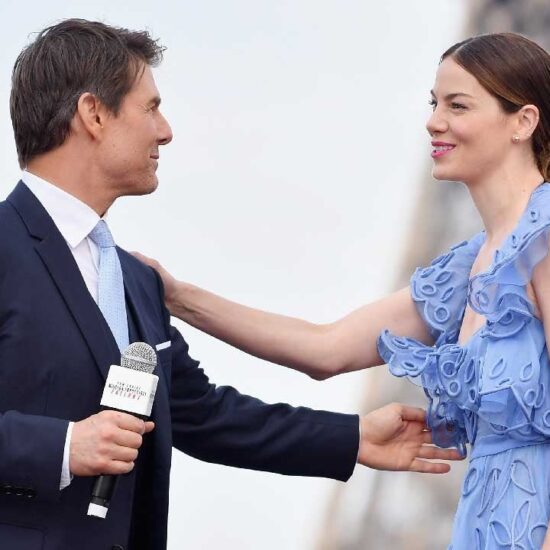
Posted by Robin Menken
“In February 1974, Brazilian musical stars Elis Regina and Tom Jobim met in Los Angeles, to record an album that would become a reference work in the history of Brazilian popular music.”
Digitally remastered from 16 millimeter footage, the film drops us into this historic, troubled and ultimately victorious meeting between two creative giants.
The filmed session is a intimate look at a Who’s Who of Brazilian musicians : guitarist-composer Oscar Castro Neves (a longtime LA transplant); guitarist Helio Delmiro (whose 1981 album with César Camargo Mariano, Samambaia, is a landmark in Brazilian instrumental music; Paulo Braga, who according to Jobim, elevated the drums as a musical instrument; Luizao Maia “the father of Brazilian bass”; percussionist Chico Batera, who recorded with every Brazilian luminary plus Frank Sinatra, Gerald Wilson, Ella Fitzgerald, The Doors, Cat Stevans, Joni Mitchell and Quincy Jones, and participated in Hollywood movie soundtracks with Michel Legrand and Dave Grusin.
Veteran producer Aloísio de Oliveira first came to Hollywood in Carmen Miranda’s Band and sang Aquarela do Brasil” (Brazil) in The Three Caballeros. As director of Brazil’s Odeon Records (now EMI), he launched the landmark bossa LP “Chega de Saudade, João Gilberto”.) He launched many more artists in solo albums on his Elenco label: Edu Lobo, Nara Leão, Nana Caymmi, Vinicius de Moraes (as a singer). In the 1960s he composed many hits with Tom Jobim (Dindi, Só Tinha de Ser com Você, Inútil Paisagem, Eu Preciso de Você, among others.)
Regina was Brazil’s most popular singing Diva
both in Brazil and abroad. She became famous when she won the inaugural TV Excelsior Festival Song Contest In 1963. Her performance and (ensuing recording) of “Arrastão” (“Pull the Trawling Net”) by Edu Lobo and Vinícius de Moraes, made her the biggest selling Brazilian recording artist since Carmen Miranda.
Her record ushered in MPB (Brazilian Popular Music). With her energetic style she championed both bossa nova and the Tropicalia composers on O Fino da Bossa, the iconic television program on TV Record.
Regina regularly toured France, Italy, Germany Switzerland. Archival footage shows concert duets with the like of Sasha Distal and Toots Theilemans.
Antonio Jobim was part of a quartet of locals who, in the 1950’s, created Bossa Nova. In the film Tom remembers his early Rio bar scenesters: (João) Donato, singer Johnny Alf, Joao Gilberto, who (along with Luiz Bonfa) were the pioneers of Bossa Nova
Young Jobim knew and studied with Hans-Joachim Koellreuter (composer-teacher who brought atonal and twelve-tone music to Brazil), knew Ary Barroso (Aquarela do Brasil aka Brazil), studied composition with Radames Gnattali, the visionary composer who developed the house band for Rádio Nacional (equally criticized for adding classical instruments to his Samba arrangements and Pop instruments to classical performances). Gnattali’s work was a precursor to Bossa and MPB.
Jobim’s other influences were Claude Debussy and Maurice Ravel and Brazilian composers Ary Barroso and Heitor Villa-Lobos. Talking with Elis he explains. Ari and VillaLobos are “my sacred juggernauts…I copy from them. You can only copy from those you love.”
Jobim, Luís Bonfá and Vinicius de Moraes collaborated on the play Orpheus of the Conception (filmed as Black Orpheus). This collaboration spread Brazilian music around the world.
Jobim wrote many of the songs on Getz/Gilberto, which became one of the best-selling jazz albums of all time, and turned Astrud Gilberto, who sang on “Garota de Ipanema” (The Girl from Ipanema) and “Corcovado”
(Quiet Nights of Quiet Stars), into an international sensation.
In 1962 Jobim appeared at Carnegie Hall with his leading jazz interpreters, tenor saxophonist Stan Getz and guitarist Charlie Byrd.
In order to get royalties and pay for his performances, he fought his way into ASACP through lyricist Ray Gilbert, then moved to LA.
Speaking (and singing) in English as well as Portuguese, Jobim collaborated with Newton Mendoca, Aloysio de Oliveira and Claus Ogerman. Major arrangements of Jobim’s compositions were written by Eumir Deodato, Nelson Riddle (The Sinatra duet Album) and especially conductor/composer Claus Ogerman
Under-appreciated in Brazil, Bossa Nova (New Beat) became popular abroad. US jazz greats were it’s earliest adopters: Dizzy Gillespie, Gerry Mulligan, Stan Getz, Ron Carter and ultimately Frank Sinatra.
Wonderful archival footage show Jobim rehearsing Desafinado with Gerry Mulligan who has trouble mastering Jobim’s sophisticated harmonies, and 1967 duets with Sinatra in LA. (Jobim harmonic ideas- like
the melody insisting on the major seventh of the chord, became commonplace in jazz after he recorded them.)
As a gift commemorating her 10 years at Phonogram (Phillips), label president Andre Midani arranged to record Elis singing songs by Tom Jobim, with Jobim.
As tales from collaborators explain, it was not an easy collaboration. Elis, whose exuberant style won her the nicknames Hurricaine and Pepper was not a fan of Jobim’s sophisticated minimalism, plus she reputedly was still smarting from an audition for the stage musical Pobre Menina Rica when Jobim rejected her.
Nelson Motta, famed producer TV personality and journalist, believed Elis considered Tom’s minimalism was for “people who couldn’t sing”. With her superb range, Elis liked to flex her muscles and shine.
Jobim met Regina at the airport. Driving to his apartment on Sunset Strip, he began quarreling about the arrangements. As his frequent songwriting collaborator producer Aloísio de Oliveira and guitarist Oscar Castro Neves remember “ Who’s doing the arrangements?” Tom barked, rejecting Regina’s new husband Cesar Comargo. “He doesn’t know American nomenclature, call Claus Ogerman. Your 27 year-old kid has no experience to compose. We need grown men.”
The wrangling continued in the studio, with Jobim expressing outrage at each of Cesar Comargo’s suggestions to incorporate an electric guitar and piano.
(Jobim played electric piano on his 1970 Stone Flower album but heard this series of songs in an acoustic vein.)
It became clear that though the label regarded Tom Jobim as a special guest on the album, It was impossible to record with Jobim unless he was in control
After sage advice from the the Label president and onsite producer Aloísio de Oliveira, Camargo eased off. Eventually he was able to integrate his ideas of electric piano, guitar and amplified base without further ruffling Jobim’s feathers. He also introduced his modern Samba beat, a key element of his countless award winning instrumental albums.
The MGM famed big band studio was closed for vacation. A receptionist did them a solid and booked them in. Chilean studio assistant Umberto Gatica, who spoke Spanish, could roughly communicate with the Portuguese crew and became the session Sound Engineer, launching his long award winning collaboration with producer David Foster (Chicago, Celine Dion, Barbara Streisand, Cher, Josh Groban, Michael Jackson, Michael Bublé and Andrea Bocelli among others. He is the nephew of Lucho Gattica, the “King Of Bolero”
Jobim’s son and others involved in the classic recording agree that the recording date with Jobim matured and changed Regina. She emerged with a sophisticated economical style that marked the rest of her tragically short career.
Regina’s troubled life led to her tragic overdose in 1982 at age 36.
The iconic album was an enormous worldwide hit and remains an inspiration for countless musicians including Bob Dylan, Madonna, Dianne Reeves, Diana Krall and Bjork.
Despite the wrangling, the session feels like a Brazilian party, an extended family. The crew lived together argued together, ate together for weeks. Regina claimed it took 18 painful days to complete the arrangements
The film seduces us, as Jobim managed to seduce or manipulate his collaborators to gain control of the session. Watching Elis and Tom practice Aquas de Marco (Waters Of March) is a joy. Elis expands, Tom radiates gratitude. The duet is sophisticated, nuanced, silken and free of any pretense. For this 10 days, they are the greatest vocal duet in the world. Elis’ emotional voice, which she can employ with percussive effect, mixed with Tom’s whisper give an earthy bottom to this album that feels like Bossa in Brazilian bars, not the sleek import featured on Sinatra’s album or Getz’s for that matter.
(The closest thing to it is the wonderful recordings of Vinicius de Moraes Toquino and Maria Creuza.)
No wonder Elis, who complained bitterly about Tom’s control issues at first, develops a crush on him. A MUST SEE. Opens in LA at Laemmle Town Center on Sept 15













